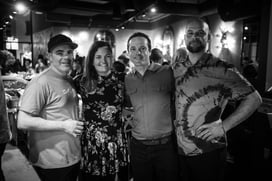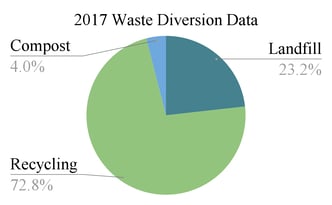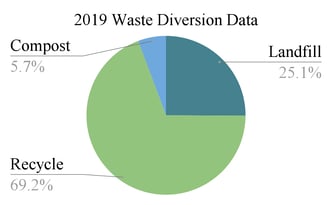The Spotlight

The way a restaurant or bar chooses to operate has far-reaching effects on the economic, environmental and social sustainability of their food and beverage operations. It can also impact company and societal culture.
With disposable to-go containers, recycling efforts, and composting initiatives, the choices a restaurant or bar makes relating to waste reduction can go a long way to either increase or decrease the amount of waste that ends up in the landfill and ultimately either aiding or hindering efforts to operate a responsible business, such as this small yet intuitively felicitous and eminently treasured example of success. By showcasing how local wine bar Root & Flower diverts their waste, feeds their employees’ creativity, and supports local sustainability practices, our hope is that they can act as a model and inspiration for other bars and restaurants in Eagle County.
Get to Know Root & Flower
Root & Flower is a wine bar that provides excellent wine and food pairing options in addition to a wide array of cocktails “crafted with the concept of bridging the gap between food and drink in Vail Village”. Located on Bridge Street in the heart of the Village, Root & Flower is also just a short walk away from its sister location, Two Arrows Coffee & Bar.
A part of the Actively Green community since 2017, there was a discernible shift in operations at Root & Flower implemented by the owners as they first sought certification and then maintained Actively Green bronze status for three years. Perhaps the most notable within this shift is how the staff has gotten creative in their efforts to reduce waste. From composting during food prep to giving employees personalized thermoses for their coffee, Root & Flower has been able to bring their waste diversion rate to a very impressive average of 75% (from 2019 data).
It’s the waste diversion rate that makes this business so unique—especially for the bar and restaurant industry. Their ability to divert waste where it is most applicable should be applauded and is what our sustainable business experts were most intrigued by: not only their willingness and ease of adapting new operational procedures but their ability to shift company culture - with a fittingly calm and cool demeanor - as well.
How They Did It
Including Composting Where Possible
One of the biggest barriers to implementing a third stream of waste - compost - in the bar and restaurant industry is knowing where compost fits in the bar and restaurant setting and knowing what can go into the compost. When these businesses get crowded with demanding customers, there’s rarely enough time to sort through platefuls of food, crayons, napkins, or otherwise and decide how each should be disposed of. Nor is there always enough space to accommodate an additional bin or bins for compost and/or recycling within the confines of a busy kitchen. However, this doesn’t mean that composting has to completely go by the wayside.
Root & Flower has worked to figure out where composting can fit into the operational equation and in the case of Root & Flower, that means adding compost to food prep and subtracting it from their busiest service times. What does this equate to? In the summer, a large pale of food scraps could commonly be so colorfully filled to include: a plethora of juiced limes, an abundance of peach pits, a dabble of lavender flower stems, a handful of walnut shells; and even the occasional red bell pepper stem. Ultimately, it’s an easy and practical procedure to enact, which can add up to a huge reduction in a restaurant or bar’s long-term environmental footprint.
Samantha Biszantz, one of the owners and director of operations at Root & Flower, recognizes the difficulties the restaurant industry faces when it comes to composting, as she says, “It’s hard for restaurants to compost because you get so busy, there’s not enough room, and it’s easily messed up...but being able to control the prep side of it makes it really possible and easy.” Samantha and her team at Root & Flower have fit composting into food preparation when employees have more time to diligently sort waste into the corresponding bins. This restaurant’s passionate group of staff has done all of this while learning along the way that small steps that add up to a significant impact.
An Action Plan
When Root & Flower began implementing compost - just after they became Actively Green Certified in 2017 - leader of the pack, Samantha, contacted a local industrial composting company, Vail Honeywagon to make the operational change official. Vail Honeywagon dropped off compost bins to Root & Flower. In addition to the composting bins they had already acquired, Samantha made sure that each employee received a one-gallon bucket for their own individual collection of home compost, making it easier for each employee to bring their compostable waste back to work. This is a great way to increase not only waste diversion as a business, but as individuals as well. The next thing she did was she talked to the staff about where composting would be implemented, which was during the preparation stage. Then they had an in depth discussion about what could go into the compost bins and what wasn’t compostable.
Finally, it took some time to get the hang of composting and making sure that all compostable items went into the compost bin during the prep stage. Over the next couple of years they started to see an increase in the amount of composting that they had, increasing their waste diversion.
Thinking Outside the Box
Part of what made Root & Flower’s waste diversion successful is their ability to find solutions in places most others wouldn’t look. When there was a problem, somebody saw a way to increase their waste diversion and decrease their footprint. For example, when oranges or limes are getting ready to go bad, they juice them, and dry the peels so they can be garnishes for their drinks. Then, so as not to use the peel and waste the juice, a bit of citric acid is added to the orange juice to preserve it for a much longer period to ensure as much of it as possible is consumed and not wasted. Additionally, they are wanting to do seasonal drinks and grow their own fruit and plants that can then become their unique seasonal drinks. All of these practices are a byproduct of more creative thinking by all employees, ultimately making solutions to wasteful and inefficient problems that work for both the company and for the customers.
Company Culture
 A point that was emphasized during our conversation with Samantha was that the staff at Root & Flower are all nature lovers. Wanting to foster and maintain this nature-loving work environment, employees are given the flexibility to take time off to take advantage of all of the great outdoor activities we have available to us here in the valley. It’s no secret that most people living in and around Vail work to be able to afford to do whatever outdoor sport, activity, or adventure their heart desires, and the owners at Root & Flower understand this. Samantha told us that at the end of the day the entire staff are “nature lovers at heart”, and this love for nature clearly doesn’t stop when they clock in. From getting on board with using refillable cleaning supply containers to refraining from using disposable cups, the Root & Flower staff have been able to fight back against the single-use habits that run rampant throughout the restaurant industry because of the desire to be good land stewards to protect the environment that they live and play in. Ultimately, the lesson to be learned is that in order to get employees on board with sustainability initiatives, they should be encouraged to enjoy the natural world the initiatives are designed to protect; allow them to want to become a champion of sustainability. It could prove to be all the difference.
A point that was emphasized during our conversation with Samantha was that the staff at Root & Flower are all nature lovers. Wanting to foster and maintain this nature-loving work environment, employees are given the flexibility to take time off to take advantage of all of the great outdoor activities we have available to us here in the valley. It’s no secret that most people living in and around Vail work to be able to afford to do whatever outdoor sport, activity, or adventure their heart desires, and the owners at Root & Flower understand this. Samantha told us that at the end of the day the entire staff are “nature lovers at heart”, and this love for nature clearly doesn’t stop when they clock in. From getting on board with using refillable cleaning supply containers to refraining from using disposable cups, the Root & Flower staff have been able to fight back against the single-use habits that run rampant throughout the restaurant industry because of the desire to be good land stewards to protect the environment that they live and play in. Ultimately, the lesson to be learned is that in order to get employees on board with sustainability initiatives, they should be encouraged to enjoy the natural world the initiatives are designed to protect; allow them to want to become a champion of sustainability. It could prove to be all the difference.
Employee Education
In addition to company culture, the owners Samantha and Jeremy take time to educate their employees however they can. In doing so, the different sustainable practices that are put into effect can be more successful in whatever the end goal may be.
Decreasing Your Contribution
Samantha discusses that she often sees inefficiencies and wastefulness in the bar and restaurant industry. As a result, she is trying to find ways to increase efficiency and decrease wasteful practices in her business. When she, or someone else, finds a solution to the problem she not only tells the whole staff what practice is changing, but encourages them to look at their habits and see how those are changing at work too.
Switching Cups
Since Root & Flower and Two Arrows Cafe are owned by the same people, Root & Flower employees get a “shifty”, or a free drink from Two Arrows during their shift. The former practice was to go over and get 5 or 6 drinks, one for each person who was working, all in single-use disposable cups. Samantha noticed this inefficiency, and didn’t want to contribute unnecessary waste to the compost or landfill every shift. So, to nix the wasteful practice of employees using disposable cups, thermoses sold at Two Arrows were bought for each employee to use for their “shifty”. After explaining to the staff what the new practice was going to be, and why the change was necessary, everyone was on board to contribute fewer cups to the waste bin. Yes, it was a simple change, but it also perfectly illustrates Root & Flower’s excellent problem solving mindset that enabled them to change a wasteful habit into an entirely sustainable one.
Decreasing Trash Bag Wastefulness
Another example of Root & Flower’s ability to problem solve and think outside the box, resulting in lasting sustainable practices, and a high waste diversion rate, is trash bag conservation. After some simple employee education, trash bags are conserved by ensuring that no partially-full bag is thrown away. Again, a very straightforward change in operation: either combine bags or wait until one fills up. But still, it’s a change that with time can make a large impact.
The Data to Back it Up
In 2019, 75% of the total waste that Root & Flower had was diverted from the landfill. The diversion rate in 2018 was 75%, and in 2017 it was 76%. What is most significant here is the consistency, and consistency at a very impressive level at that. For perspective, the average waste diversion rate in Colorado in 2018 was 17.2%. While a composting rate of 4%, 4.6%, and 5.7% may not seem particularly high, the average composting in the rate in the US was 4.1% in 2018. Root & Flower again performs above average, which is all the more impressive considering the US average includes all individuals and businesses, not just restaurants and bars.



Conclusion
To put it simply: Root & Flower are a perfect example showing that it’s not hard for a restaurant to put in a bit of extra effort in order to operate more sustainably. Doing little things here and there can really add up, and with a waste diversion rate of 75%, everyone at Root & Flower can certainly attest to that. They also show us why it’s essential to encourage and enable employees to enjoy nature and to educate employees on sustainability practices in order to have successful sustainability initiatives. Clearly, a nature-loving employee culture makes sustainability at work a no-brainer for everyone who walks through the door.
Finally, when asked why she believed other restaurants and bars should look into improving their own sustainability practices, Samantha responded by explaining how, due to various health regulations that create so much packaging and waste, restaurants will always inherently be unbelievably wasteful operations, but also that that doesn’t mean they should just accept it. For example in regards to composting she says, “just start with the prep and see how crazy you can get!” Well, we think that is excellent advice that can go far beyond the confines of composting. You just have to start somewhere, get the ball rolling, get employees engaged, and before you know it, sustainable practices will become second nature.
Tell us how you have incorporated sustainability into your business's operations by taking a stab at the Green Business Trail Map Checklist Form!






